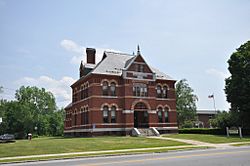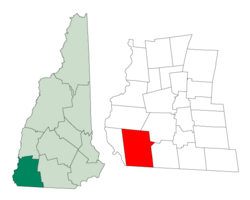Winchester, New Hampshire facts for kids
Quick facts for kids
Winchester, New Hampshire
|
||
|---|---|---|
|
Town
|
||

|
||
|
||

Location in Cheshire County, New Hampshire
|
||
| Country | United States | |
| State | New Hampshire | |
| County | Cheshire | |
| Incorporated | 1753 | |
| Villages |
|
|
| Area | ||
| • Total | 55.6 sq mi (143.9 km2) | |
| • Land | 55.0 sq mi (142.4 km2) | |
| • Water | 0.6 sq mi (1.5 km2) 1.01% | |
| Elevation | 433 ft (132 m) | |
| Population
(2020)
|
||
| • Total | 4,150 | |
| • Density | 75/sq mi (29.1/km2) | |
| Time zone | UTC-5 (Eastern) | |
| • Summer (DST) | UTC-4 (Eastern) | |
| ZIP codes |
03470 (Winchester)
03441 (Ashuelot) |
|
| Area code(s) | 603 | |
| FIPS code | 33-85540 | |
| GNIS feature ID | 0873757 | |
Winchester is a town in Cheshire County, New Hampshire, in the United States. About 4,150 people lived there in 2020. The main part of town, called the Winchester census-designated place (CDP), had 1,606 residents in 2020. The town also includes the village of Ashuelot and a section of Pisgah State Park.
Contents
History of Winchester
Winchester was first called "Arlington" in 1733. It was named after Charles Fitzroy, the Earl of Arlington. This town was one of many created by Governor Jonathan Belcher. Its purpose was to protect the border of the Massachusetts Bay Colony along the Connecticut River.
In 1741, Winchester became part of the Province of New Hampshire. Governor Benning Wentworth officially made it a town in 1753. He renamed it "Winchester" after Charles Paulet, the 8th Marquess of Winchester.
Early Settlers and Challenges
Pioneers started arriving in Winchester as early as 1732. They faced many attacks from Native American tribes. Several settlers were captured, and the town was even burned down in 1745.
The town's church was founded in 1736. It is the oldest religious group in Cheshire County. Winchester is also home to two historic covered bridges.
Important Events and Industries
In 1803, a major statement of Universalism was adopted in Winchester. This statement, called the Winchester Profession, was very important to the Universalist faith.
Winchester has always been an agricultural town. However, many small businesses also grew here. In the 1830s, Graves & Company became one of the first companies in the country to make musical instruments.
When the Ashuelot Railroad arrived in 1850, it helped new industries grow. These included textile mills, factories making wooden items like boxes, and leather tanning businesses.
Geography of Winchester
Winchester covers a total area of about 143.9 square kilometers (55.6 square miles). Most of this area, about 142.4 square kilometers (55.0 square miles), is land. The remaining 1.5 square kilometers (0.6 square miles) is water, making up about 1% of the town's total area.
Rivers and Mountains
The town is drained by the Ashuelot River and a smaller stream called Mirey Brook. Pisgah Reservoir and Kilburn Pond are two bodies of water located in the northwest part of Winchester. All the water in the town eventually flows into the Connecticut River.
The highest point in Winchester is Franklin Mountain. It is about 434 meters (1,424 feet) tall and is located near the northeastern corner of the town.
Travel and Nearby Towns
Winchester is connected by several state routes. These include Route 10, Route 78, and Route 119.
Winchester shares its borders with several other towns:
- To the north: Chesterfield
- To the northeast: Swanzey
- To the east: Richmond
- To the south: Warwick, Massachusetts
- To the southwest: Northfield, Massachusetts
- To the west: Hinsdale
People of Winchester
| Historical population | |||
|---|---|---|---|
| Census | Pop. | %± | |
| 1790 | 1,209 | — | |
| 1800 | 1,413 | 16.9% | |
| 1810 | 1,478 | 4.6% | |
| 1820 | 1,849 | 25.1% | |
| 1830 | 2,051 | 10.9% | |
| 1840 | 2,065 | 0.7% | |
| 1850 | 3,296 | 59.6% | |
| 1860 | 2,225 | −32.5% | |
| 1870 | 2,097 | −5.8% | |
| 1880 | 2,444 | 16.5% | |
| 1890 | 2,584 | 5.7% | |
| 1900 | 2,274 | −12.0% | |
| 1910 | 2,282 | 0.4% | |
| 1920 | 2,267 | −0.7% | |
| 1930 | 2,183 | −3.7% | |
| 1940 | 2,275 | 4.2% | |
| 1950 | 2,388 | 5.0% | |
| 1960 | 2,411 | 1.0% | |
| 1970 | 2,869 | 19.0% | |
| 1980 | 3,465 | 20.8% | |
| 1990 | 4,038 | 16.5% | |
| 2000 | 4,144 | 2.6% | |
| 2010 | 4,341 | 4.8% | |
| 2020 | 4,150 | −4.4% | |
| U.S. Decennial Census | |||
In 2010, there were 4,341 people living in Winchester. These people made up 1,689 households and 1,129 families. About 96.1% of the people were white. Small percentages were African American, Native American, or Asian. About 1.8% of the population was Hispanic or Latino.
About 31.9% of households had children under 18 living with them. Many households (47.5%) were married couples. The average household had 2.54 people.
The median age in Winchester was 41.1 years. This means half the people were older than 41.1 and half were younger. About 22.9% of the population was under 18 years old.
Culture and Fun in Winchester
Since 1998, Winchester has hosted its yearly Pickle Festival. This fun event takes place every September on Main Street.
Places to Visit in Winchester
- Ashuelot Covered Bridge: A historic covered bridge.
- Conant Library Museum: A place to learn about local history.
- Monadnock Speedway: A popular place for car racing.
- Sheridan House (1870): This building is home to the Winchester Historical Society Museum.
Famous People from Winchester
Many notable people have connections to Winchester:
- Jane Grace Alexander (1848–1932): A well-known banker.
- Henry Ashley (1778–1829): A US congressman.
- Michael Dubruiel (1958–2009): A Roman Catholic author.
- Louis B. Goodall (1851–1935): An industrialist, banker, and US congressman.
- Marshall Jewell (1825–1883): He served as the 25th US Postmaster General and was governor of Connecticut multiple times.
- Francis P. Murphy (1877–1958): The 64th governor of New Hampshire.
- Addison Pratt (1802–1872): An early Latter-day Saints missionary. He was the first Latter-day Saint missionary to preach in a language other than English.
- Leonard Wood (1860–1927): A US Army chief of staff.
See also
 In Spanish: Winchester (Nuevo Hampshire) para niños
In Spanish: Winchester (Nuevo Hampshire) para niños







